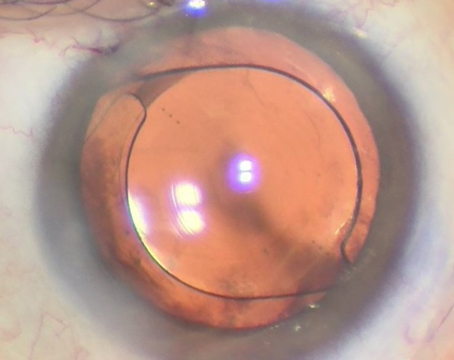As most medico-legal experts have been drumming into surgeons' heads for at least the past six years, unrealistically high patient expectations are harbingers of a lawsuit in refractive surgery. Now, with the advent of customized, wavefront-guided ablations, how can surgeons control expectations when patients may be hearing that these new procedures are better than conventional LASIK and may even be able to give them "super vision"? In this article, experts provide advice on how to manage patient expectations, deal with informed consent and advertise properly in the era of custom ablations.
First Contact: Advertising
Though the laser makers pull out all the stops when it comes to sparking surgeons' interest in custom ablations, the surgeons interviewed in this article say they tone it down when it comes to advertising to their patients.
 |
Chicago surgeon Colman Kraff performs custom ablations and participated in the U.S. Food and Drug Administration trial of the Visx WavePrint system.
"Whenever a patient hears about new technology that could potentially give him a better result with respect to quality of vision and acuity, he probably expects to see better after the procedure," says Dr. Kraff. "I don't advertise the superiority of custom treatments or the technology itself. I market myself when I advertise LASIK. It's a practice we've done for several years. I don't know if it's the right approach, but I think it helps control patient expectations."
"I'm taking a low-key approach, and don't advertise the custom treatments," says Minnesota surgeon David Hardten. "I'm defining [custom treatment] as an incremental improvement, like going from no eye-trackers to trackers or from smaller optical zones to larger ones. If you don't approach it this way, patients put too much emphasis on the technology." He says that comparing it favorably to conventional treatments in the hope of "selling up" a patient creates false expectations that could backfire. "What happens if the patient ends up uncorrected by -0.75 D or has flap striae?" he says. "You promised him the potential for 20/10 vision but now he's got flap striae, how do you explain that?"
Richard Abbott, MD, professor of clinical ophthalmology at the University of California-San Francisco and chair of the underwriting committee for the Ophthalmic Mutual Insurance Co., says that, according to the Federal Trade Commission, if you must advertise the technology's benefits, then you have to advertise its drawbacks, as well.
"One couldn't say, 'Come to our laser center with the latest wavefront technology that offers 20/20—or even better than 20/20—vision,' without a disclaimer that says, 'Every patient may not receive these benefits,''' he says. "There has to be a balance."
Handling Informed Consent
Though patients may be high on custom ablation when they come into a surgeon's office, physicians say the informed consent process lets them bring patients back down to earth.
"The risks are basically the same between custom and conventional LASIK," says San Diego surgeon Steven Schallhorn. "Patients need to understand that they may need additional procedures, may not obtain their best vision without wearing glasses, and may have difficulty with night vision, glare, haze and/or halos. The risks of these are less with custom treatment, but they're still present ... The idea of analyzing higher-order aberrations and using them to guide treatment represents a paradigm shift, but current LASIK techniques still have significant limitations. LASIK still relies on the microkeratome and there remain problems and risks associated with cutting a flap. In addition, there are a substantial number of patients outside the current approved range for custom treatments."
"With wavefront renewing heightened expectations, the risk of not meeting them and having an unhappy patient are greater," says Dr. Abbott. "So, the same precautions and advice regarding proper informed consent have to be followed even more closely, because of the hype in the marketplace about what wavefront technology can do." He adds that, of course, informed consent that's done on the day of surgery, without giving someone enough time to make an informed decision, is considered to be invalid.
Denver lawyer Gregory Tiemeier, who represents surgeons in LASIK suits, says informed consent is critical.
"Sometimes, the staff sees the informed consent discussion as a chore that they have to get through rather than an opportunity to educate a patient about the risks, benefits and alternatives," he says. "Instead, it may be more like cheerleading, [with the staff saying], 'This is great, you'll love it, you'll be happy when we're done.'" And, if the patient isn't happy, Mr. Tiemeier says the patient concludes that something went wrong.
• Patients and perceptions. Several of the experts say the informed consent process is also a good time to identify patients whose personality may predispose them toward being dissatisfied postop.
Dr. Abbott will present a study of the risk factors for a refractive lawsuit at this year's meeting of the American Academy of Ophthalmology. He says the risky personality types that emerged were usually "professionals that tended to be fastidious and compulsive about most things in their lives, such as engineers and accountants." Mr. Tiemeier would add pilots, doctors and lawyers to that list, and says many of the plaintiffs he sees in court work in professions where an almost obsessive attention to detail is encouraged. He notes that someone who obsesses over everything isn't an ideal candidate.
Anne Menke, RN, PhD, the risk manager for OMIC, says that, if a patient can clearly explain the procedure and his motivations for having it done, that's a good gauge of his expectations and understanding.
"Never do the procedure on the day you first meet with patients to discuss the surgery," she says. "When patients come back to schedule the surgery, have a staff member ask them, 'What are you having done and why?' If they can't satisfactorily explain it to you in their own words, explain the procedure again or give them more information and document the discussion." She says the "why" is especially important. If a patient says custom LASIK will "make him more desirable" or "make him feel better about himself," that's not as realistic as someone who says he wants to have it to "avoid situations where I have to deal with my glasses steaming up."
As of this writing, OMIC is preparing to post an update to its informed consent document in light of custom LASIK on its website omic.com.
• Switching procedures mid-stream. If a patient is told he qualifies for a custom treatment, but then his surgeon ultimately can't perform the treatment due to tear-film irregularities, pupil size or other difficulties, the natural reaction might be to perform a conventional treatment. Mr. Tiemeier counsels surgeons to resist this urge.
He says, "I can hear a plaintiff's attorney making the argument: 'Doctor, do you charge more for a wavefront procedure? How much more? So, doctor, even though you were aware that Dr. Jones in your town has a different wavefront-based system that may have been able to perform the procedure on the patient, you chose to perform an inferior procedure instead, rather than lose the patient to Dr. Jones, correct?'''
Mr. Tiemeier says that, more often than not, just offering patients the option of going to another doctor will probably make them feel comfortable with you. "If you offer the option of another surgeon [with a different wavefront system] and then document it," he says, "at least you won't hear at trial that the only people whose best interest were being kept in mind were yours and your banker's."





